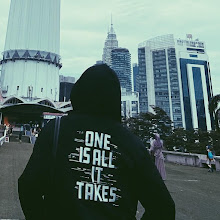 by Norman Yusoff
by Norman YusoffFirst and foremost, let me share with you the fact that my interest in this topic was triggered by a series of events during my holiday in my homeland of Malaysia in December. This included my visits to two lovely, culturally fascinating cities, one in the Muslim-majority country of Bangladesh (Dhaka) and the other in the most ‘Islamist’ state of Malaysia, Kelantan (Kota Baharu). I also managed to catch up with the latest state of Malaysian cinema and television which, to my understanding, are experiencing an escalation of the Islamisation process. Many local telemovies, soaps, and reality shows (such as Ustazah Pilihan) appearing on television feature Islamic themes, value, and outlooks; as well, I noted more fictional characters and real-world celebrities wearing hijabs and sporting jangguts. I must confess that never before have I considered the prospect of becoming an ustazah (religious teacher) glamorous and celebratory.
Throughout my periods of research in Malaysia, I watched several contemporary local films, either at the cinema, on TV or DVD, and noted that some, e.g., Syurga Cinta (Paradise of Love, 2009, Ahmad Idham), Aku Masih Dara (I am still a Virgin, 2010, Ahmad Idham) and Nur Kasih The Movie (2011, Kabir Bhatia) explored Islamic themes in a somewhat overt manner. While the yummy-sounding romantic comedy Karipap-Karipap Cinta (Curry Puffs of Love, 2011, Hafsham) featured a hip, semi-tudung-clad graduate from Cairo’s Al-Azhar University as its female protagonist, the cloyingly melodramatic box-office hit Ombak Rindu (The Pining Wave, 2011, Osman Ali) portrayed its female protagonist as an ustazah. A more recent (yet to be released) film, Tujuh Petala Cinta (Seven Petals of Love, 2012, Azhari Zain) has gone the extra mile, depicting a burqa-clad female protagonist, while at the same time touting itself as an ‘Islamic Romantic Film.’ ... Excuse me???
I am surmising that the birth of films such as Tujuh Petala Cinta and others of similar ilk must have been influenced by the proliferation of Islamic-themed films in neighbouring country Indonesia. I myself have seen several of them, from Emak Ingin Naik Haji (Mother Wants to Perform Haj, 2009, Aditya Gumay),Syahadat Cinta (Creed of Love, 2008, Gunawan Paggaru), Sang Pencerah (The Enlightener, 2010, Hanung Bramantyo), Jakarta Maghrib (2010, Salman Aristo), to Di Bawah Lindungan Ka’bah (Under the Protection of Ka’bah, 2011, Hanny Saputra). The media, in particular, often refer to this type of film as ‘Islamist Pop Cinema,’ ‘Islamic Cinema,’ or ‘Muslim Cinema,’ a form of subjectivity defined in adjectival terms with ‘Islam’ or ‘Muslim’ as the master signifier. In Malaysia, this fixation over naming or labelling everything as ‘Islam’ (or at least ‘halal’) is hardly new; a more recent case saw a brouhaha over the issue of indelible ink, which has prompted the religious authority to quickly endorse and label it ‘halal.’
If one reads widely within the circuits of both academic and popular discourse, one will uncover some Malaysian critics’ and academics’ propensity for employing the appellation ‘Islam’ to refer to a body of films that explore Islam as their main theme. For example, Malaysian academic Naim Ahmad, a professor of communication at an Islamic university college, has written a book titled Filem Islam: Satu Pembicaraan (‘Islamic Film: A Discussion’). In his work, Naim’s definition of an ‘Islamic film’ is generally circumscribed to Islam’s external and exoteric aspects, further contributing to the prevailing narrow and exclusive interpretation of Islam. The work is further compounded by his occasional ‘literal’ use of edicts and quotes from the Qur’an and the Sunnah, which he does solely to support his general claims and statements, leaving no room for sound argument, substantial analysis and synthesis.
Naim’s coinage of the term ‘Islamic film’ remains somewhat vague in its definition and aim(s). It is unclear as to what he wants to propose: a critical concept or theorisation for introduction and use in academic disciplines such as film or media studies maybe? He seems not to touch at all upon the prospect of cinema as a source of knowledge; for example, there is no discussion of how cinema can be used to illustrate and discourse Islamic tenets, philosophy, and teachings. Such shortcomings underpin his work’s lack of academic rigour. The term ‘Islamic film’ itself may imply different meanings, agendas and scopes with regard to the relations between cinema and Islam. It can also mean a type of film movement by or about Muslims (often referred to as ‘Muslim cinema’).
At times, Naim strongly emphasises the legalistic aspects (the dos and don’ts) of the Shari’ah (Islamic law and rituals) such as the halal way of filmmaking. This leads to him claim that to date, Malaysian cinema has never produced an ‘Islamic film’ in the truest sense of the word – a point that I do not totally disagree with; but, I would ask: Why does one need to search for a pure or authentic ‘Islamic film’ in the first place? For Naim, there are films which can be considered as having Islamic elements (such as P. Ramlee’s Semerah Padi [1956] and Yasmin Ahmad’s Muallaf [The Convert, 2008]) because according to him, a ‘pure Islamic film’ should take into account the most important details of all aspects of production (including behind the scenes) which should be in line with the Shari’ah. For example, Naim asserts that the aforementioned films possess some Islamic elements but cannot be regarded as ‘pure Islamic films’ due to the fact that certain aspects such as Islamic dress and decorum do not fully conform to the Shari’ah. Had this been Naim’s main intention, he should have come up with a manual as guidance for our Muslim filmmakers in the film industry.
Naim’s call for Muslim filmmakers to produce works that merit the label of ‘Islamic cinema’ should be lauded. However, this tendency may lead to narrow, reductive, essentialist and prescriptive definition of what ‘Islamic cinema’ is. Understandings of what constitutes a good ‘Islamic’ film may vary from one filmmaker to another, and be open to diverse interpretations, opinions, and contestations; for some, this may appertain to films that stress stereotypical ‘Islamic’ (or to be precise, ‘Arabic-influenced’) outlooks and settings. For example, when FINAS (National Film Development Corporation of Malaysia) organised an Islamic Film Festival in 2009 (in conjunction with the OIC conference), unfortunately the selected local film was Syukur 21 (2000, Eddie Pak), which accentuates a more ‘literal’ portrayal of Islam. It is indeed a sad outcome if a good, prototypical ‘Islamic film’ is only superficially understood by organizers.
But, for others, provocative works by the late Yasmin Ahmad such as Rabun (My Failing Eyesight,2003), Gubra (Anxiety, 2006) and Muallaf, which offer a brand of Islam that promotes love, mercy and compassion, may meet the defining criteria of ‘Islamic film.’ Yasmin’s works met with a vituperative backlash from conservative Muslims (such as columnist Akmal Abdullah) due to her depiction of an Islam that contravenes the mainstream version prescribed and practiced in Malaysia. While some expressed genuine outrage, others were confused but comfortingly liberating. The attack on Yasmin at the time her films were released certainly made us think afresh about the point and place of cinema in relation to religion (particularly Islam), and about its relation to dissent. The good thing is that all of this has sparked debate about (Malaysian) cinema’s compatibility or incongruity with religion and spirituality.
One good example is Indonesia’s Laskar Pelangi (The Rainbow Troops, 2008, Riri Riza), which is saturated not only with Islamic essence but also with the spirits of Indonesian-ness (nationalism) and Malayness (ethnic/cultural identity). Set in the 1970s on Belitung island off the east coast of Sumatra,Laskar Pelangi focuses upon a group of poor children attending a ramshackle Islamic primary school. I suspect that a good film such as this would not meet Professor Naim’s required definition due to the depiction of the students and their female teacher exposing their awrat (the former wearing shorts and their female teacher wearing a loose selendang [a type of shoulder cloth draped over the head with a little display of forehead hair]). All credits to director Riri Riza for retaining the authenticity of the socio-cultural reality of Indonesia in the 1970s, a time when Southeast Asian Muslims were less concerned with Islamic dress and customs (Can you imagine if today’s Islamic school students and teachers dressed in such attire? I believe they would be heavily frowned upon and considered ‘un-Islamic’).
What is crucial is the film’s subtext that epitomises Islamic spirit and essence, that is, the importance of pursuing knowledge/education as a path or journey to wisdom and salvation, a journey that will liberate the students from the clutches of jahiliyyah (‘ignorance of divine guidance’) and prepare them to attain the status of insan-ul kamil (ideal beings). This means, as the film shows throughout, that these young Muslims are educated in more than religious formalism.
Laskar Pelangi is not bogged down by pretension and superficiality when it comes to characterisation and portrayal of mannerisms, as evident in other Indonesian films such as Ayat-Ayat Cinta (Verses of Love, 2008, Hanung Bramantyo), Perempuan Berkalung Sorban (Woman with a Turban, 2009, Hanung Bramantyo) and Ketika Cinta Bertasbih (When Love is Extolled, 2009, Chaerul Umam) – even Malaysia’s Nur Kasih or the intellectually stultifying Aku Masih Dara for that matter. The problem with most of the films of this type may be found in their idealistic and utopian portrayal of Puritanism by means of characters/characterisation which lead(s) to unrealistic contrivances. The least appealing aspect is having characters berkhutbah (sermonise), having them deliver didactic lines in a self-righteous and sanctimonious manner. Although cinema can be used to propagate goodness and virtue (tujuan berdakwah), I believe that in today’s sophisticated world it has to be done both subtly and non-invasively.
Having mentioned the above examples, there are films that may explicitly invoke Islamic values, themes, teachings, and/or thought (such as Indonesia’s Ketika Cinta Bertasbih). But, we should bear in mind that there are also films containing scenarios which although not necessarily explicitly promoting Islamic tenets and themes may be used to explore, reflect on and for discussion of matters related to Islam (such as ...Dalam Botol [In a Bottle, 2011, Khir Rahman] – although this does not quite exemplify what Professor Naim has defined). We should welcome a more diverse and varied exploration of Islamic themes and ideas (as well as representation of Muslims) that are inclusive, fluid and open.
Take Iranian cinema for example. The Iranians themselves have never claimed and labelled their films ‘Islamic.’ The works of Majid Majidi and Abbas Kiarostami, for example, are deeply imbued with influences and the poeticism of Persian Sufism, enabling them to deal with a wide range of subject matter from women’s emancipation to taboo issues such as suicide. My favourite Bangladeshi director Tareque Masud’s beautiful film, The Clay Bird (2002), which depicts the daily lived reality of a madrasahschoolboy in 1960s East Pakistan (now Bangladesh), critiques those who like to twist the words of God for their political ends. From the story, which is set against the increasing tension culminating in the 1971 Bangladesh War of Liberation (from West Pakistan), we come to learn that some versions of Islam in South Asia is inextricably bound up with Indian-Hindu cultures. American director Spike Lee’s powerful biography Malcolm X (1992), which focuses upon the life and times of a controversial African American civil rights leader who converted to Islam, not only foregrounds Islam but is also interlaced with issues of racial politics. I believe that some aspects of Islam in the film may be greeted with disapproval by the majority of Malaysian Muslims, further reflecting complex Muslim subjectivities.
If Islam is regarded as deen (‘a way of life’), there is no need to conceive of it in terms of an identity marker that defines Islamic/Muslim subjectivities narrowly and enforcedly. This may only lead to a culture of paranoia among we Muslims, further reflecting our deep sense of fear and insecurity regarding the Other. In my opinion, Islamic/Muslim subjects are not arborescent (tree-like), i.e., not producing a distinct order and direction. In essence, they are more rhizome-like. French philosopher Gilles Deleuze explains ‘rhizome’ (or ‘rhizomatics’) as dealing with random, proliferating and de-centred connections, connections that do not begin from a distinction and hierarchy between ground and consequence, cause and effect, subject and expression. According to Deleuze, any point can form a beginning or point of connection for any other. This should discourage us from thinking of Islam as something couched in terms of tribalism or clan-ism.
Resorting to the politics of labelling will only impede the possibility of the cinematic message reaching everyone – perhaps the possibility of cinema as another means of looking at and understanding Islam as well as our function in society vis-a-vis the Others (non-Muslims). For example, one way is to contemplate cinema as a unique and specific medium through which questions of aesthetics can be explored as a major component of religious revelation. This can extend to using the medium to manifest the journey towards absolute love of the Divine – to arrive at the ‘gnosis’ of the Human Level (as insan-ul kamil). It is at this point that Islam becomes thoroughly inclusive of human life rather than being parochially exclusive, defensive and dogmatic. Only then can the potential of the cinema be utilised as a source of insight that can shed light on – and help conceive of – the whole of humanity as one ummah(global community).



















%20WAJIB%20TONTON%20COVER%20PAGE%20(21).png)
%20WAJIB%20TONTON%20COVER%20PAGE%20(22).png)
%20WAJIB%20TONTON%20COVER%20PAGE%20(20).png)
.png)
1 Ulasan